Latin America Domestic Courier, Express, and Parcel Market Size
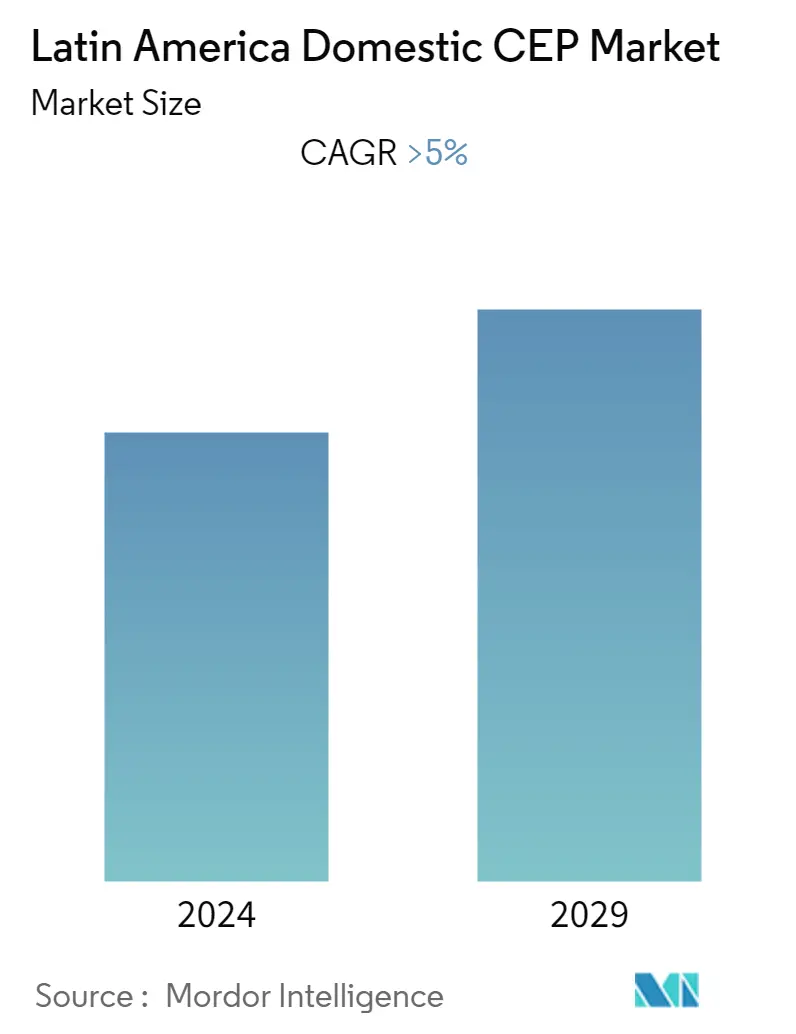
| Study Period | 2020 - 2029 |
| Base Year For Estimation | 2023 |
| Forecast Data Period | 2024 - 2029 |
| Historical Data Period | 2020 - 2022 |
| CAGR | 5.00 % |
| Market Concentration | Low |
Major Players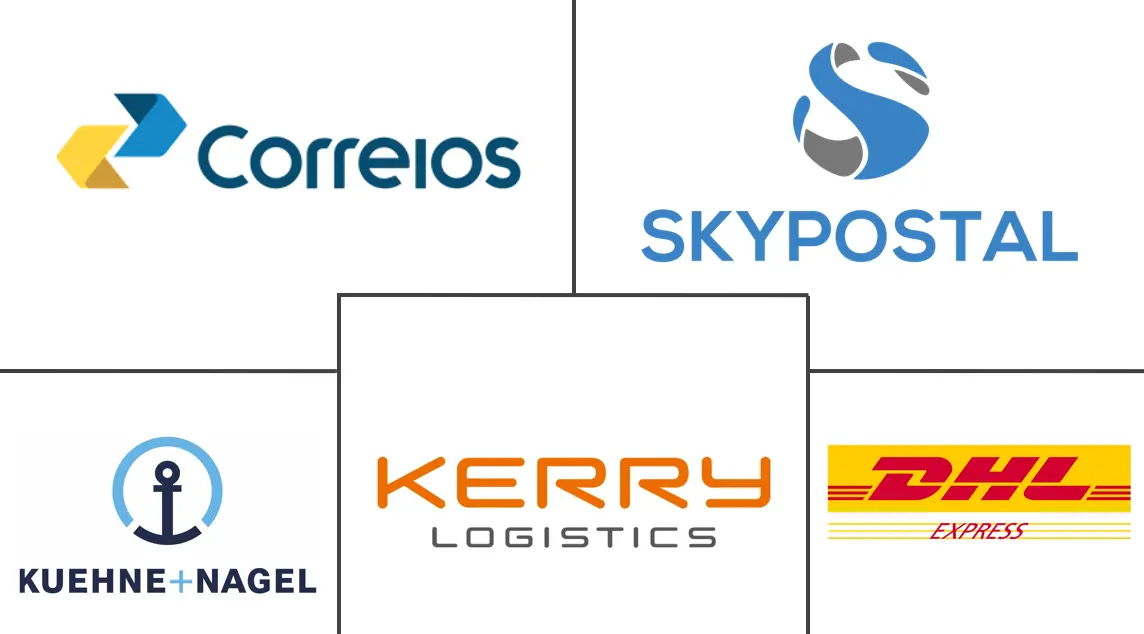
*Disclaimer: Major Players sorted in no particular order |
Latin America Domestic Courier, Express, and Parcel Market Analysis
The Latin American Domestic Courier, Express, and Parcel (CEP) market is estimated to witness a CAGR of more than 5% during the forecast period (2022-2027).
In the wake of the COVID-19 pandemic, digitization began to play an increasingly important role in the region. Latin Americans are making unprecedented purchases through digital means. The current wave of increasing digitization is expected to continue. With the surge in e-commerce during the pandemic, demand has suffocated the supply chain, limiting retailers' capacity to fulfill orders and restock the inventory as quickly as customers need it. Logistics services have fresh potential to acquire consumers, the first ones in the post-COVID phase, with the reviving of international commerce.
Between January and May 2021, Mexico remained the United States' top commercial partner, with 14.7% involvement and the expectation of increased imports, exports, and, potentially, commercial services, with logistics being among the most desired. In April 2021, Mexico became the United States' first business partner in terms of goods exchanges only, without including services. Mexico accounted for 14.7% of total merchandise exports and imports in the fourth month of the year, ahead of Canada (14.2%) and China (13.3%).
The e-commerce market in Mexico is strong and growing stronger, with revenue estimated to reach USD 21 billion by the end of 2021 at an annual growth rate of 3.8% and projected market volume to reach USD 24 billion by 2024. With internet penetration currently at 74% and with more than 45% of the population aged between 25-54 years old, there is scope for even more growth. The most popular category for online shoppers in Mexico is currently Electronics and Media (USD 6.42 billion), then Fashion (USD 5.2 billion).
Latin America Domestic Courier, Express, and Parcel Market Trends
This section covers the major market trends shaping the Latin America Domestic CEP Market according to our research experts:
Growing Opportunities in Brazil to Drive the Market
Many businesses began expanding their logistics operations to take advantage of the CEP's potential for quick expansion. DHL, for example, has been growing throughout the region and investing in new technology to increase the efficiency of its supply networks. Brazilians are well-known for being among the first to accept new technology. A flourishing digital goods and services industry already exists in the country. Brazil is a fertile ground for digital goods, and it is also the region's most competitive market. The significant growth of e-commerce in 2020 is attributable to the shift of consumption from physical stores to the digital realm, which resulted in more than 17 million Brazilians having their first online buying experience, a 23% increase.
The domestic postal traffic in Mexico amounted to approximately 285.4 million items handled in 2020. This represented a decrease of around 20.5% in comparison with the number of items transported a year earlier. The Mexican Online Sales Association estimated that the domestic eCommerce business was worth USD 15.8 billion in 2020, up by 81% from 2019. In 2020, 50.7 million Mexicans used eCommerce, up by 9% from the previous year. Food delivery was the most popular online transaction in 2020, followed by fashion and beauty products. Purchases from online pharmacies and supermarkets climbed by 41% and 40%, respectively.
In 2021, Brazil experienced robust growth in e-commerce sales by 48.4% when compared to 2020, as consumers adopted online shopping in a greater proportion. In November 2021, e-commerce represented 17.9% of retail sales, a huge record since January 2018. Also, in 2021, the most popular e-commerce categories were equipment and supplies for the office, IT, and communication, with more than 43% of sales, followed by furniture and appliances, apparel, etc.
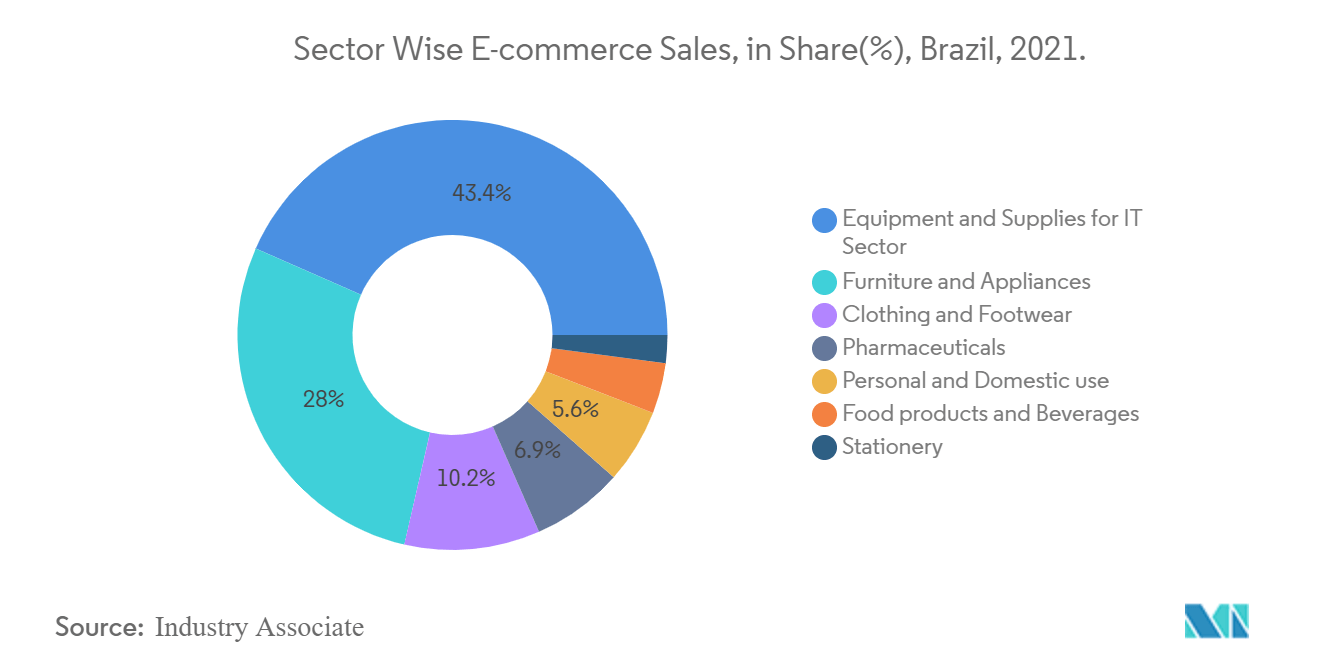
E-commerce Driving the Market
E-commerce in Argentina is emerging in the Latin American region, as the retail e-commerce sector saw a significant growth of more than 79% in 2020. Brazil and Mexico are driving Latin America's e-commerce sector. Brazil has the largest share of e-commerce in Latin America, and the market was worth USD 19.6 billion in 2020, comprising 53.5% share. In 2021, more than 188 million people opted to shop online in Latin America. Online shoppers are expected to spend more over time. The average online user spending in 2021 accounted for more than USD 220.
Rising internet penetration is driving the market. In 2021, internet penetration in Latin America was at 71%, and smartphone penetration was at 69% of the total population. Penetration rates are higher in urban areas. Brazil was the leading country, with more than 165.3 million internet users in January 2022, followed by Mexico and Argentina. In 2022, Mexico's internet users made the highest e-commerce purchasing, as more than 64% of internet users purchased consumer goods via e-commerce platforms. Also, more than 39% of people order groceries via online stores.
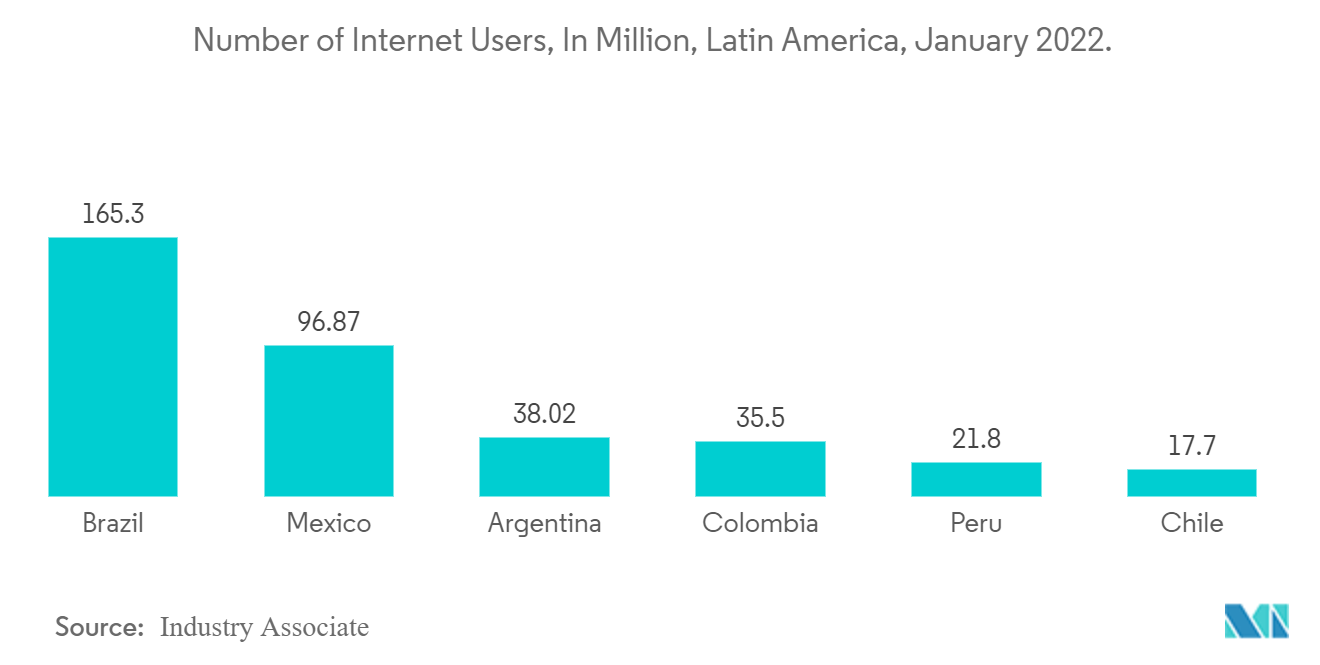
Latin America Domestic Courier, Express, and Parcel Industry Overview
Latin America Domestic CEP Market is fragmented in nature with a mix of global and local players. This makes the sector highly competitive. Some of the strong players in the country include Brazil Post, Sky Postal, Kuehne Nagel, Kerry Logistics, and DHL Express. Many businesses began expanding their logistics operations in order to take advantage of the CEP's potential for quick expansion. DHL, for example, has been growing throughout the region and investing in new technology in order to increase the efficiency of its supply networks. Brazilians are well-known for being among the first to accept new technology. A flourishing digital goods and services industry already exists in the country. Brazil is a fertile ground for digital goods, and it is also the region's most competitive market.
Latin America Domestic Courier, Express, and Parcel Market Leaders
-
Brazil Post
-
Sky Postal
-
Kuehne Nagel
-
Kerry Logistics
-
DHL Express
*Disclaimer: Major Players sorted in no particular order
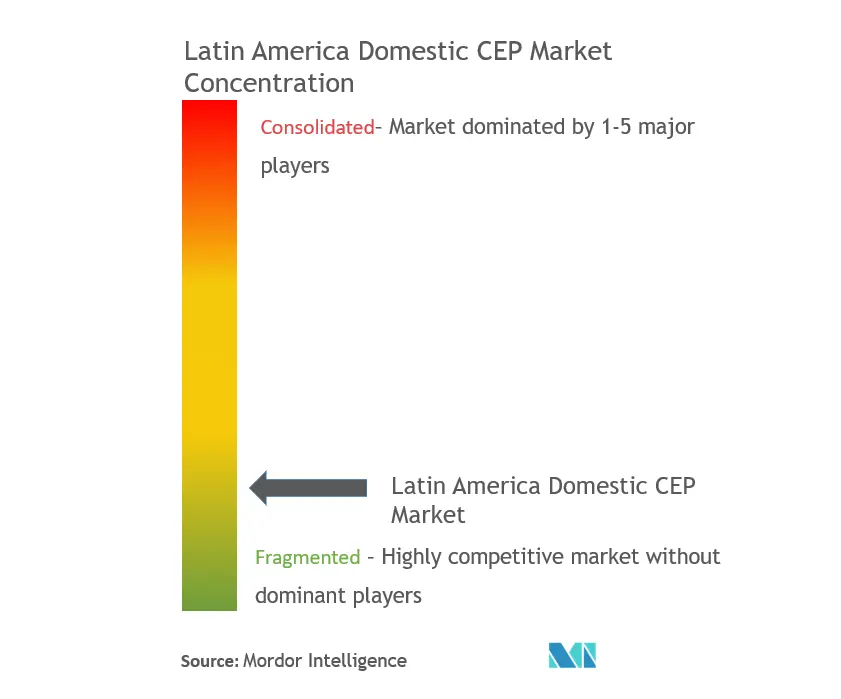
Latin America Domestic Courier, Express, and Parcel Market News
August-2021: DHL (the leading international provider of air, sea, and road freight services) has launched its digital logistics platform Saloodo! for shippers and transport providers in Argentina. This provides shippers and carriers with a one-stop platform for road freight connections. Also, this digital platform recommends suitable prices based on current market data and makes all transportation documents digitally available.
July 2021: Kerry Logistics Peru SAC (Kerry Logistics Peru) began operations in July 2021, expanding Kerry Logistics Network's presence in Latin America, increasing its international freight forwarding capability, and tapping into the Peruvian export trade.
Latin America Domestic Courier, Express, and Parcel Market Report - Table of Contents
1. INTRODUCTION
- 1.1 Study Assumptions and Market Definition
- 1.2 Scope of the Study
2. RESEARCH METHODOLOGY
- 2.1 Analysis Methodology
- 2.2 Research Phases
3. EXECUTIVE SUMMARY
4. MARKET INSIGHTS
- 4.1 Current Market Scenario
- 4.2 Technological Trends
- 4.3 Government Regulations
- 4.4 Overview of the Logistics and Warehousing Market in Latin America
- 4.5 Brief on Freight Forwarding Market in Latin America
- 4.6 Industry Supply/Value Chain Analysis
- 4.7 Spotlight on the E-commerce Sector in Latin America
- 4.8 Impact of COVID-19 on the CEP Market
5. MARKET DYNAMICS
- 5.1 Market Drivers
- 5.2 Market Restraints
- 5.3 Market Opportunities
-
5.4 Porter's Five Forces Analysis
- 5.4.1 Threat of New Entrants
- 5.4.2 Bargaining Power of Buyers/Consumers
- 5.4.3 Bargaining Power of Suppliers
- 5.4.4 Threat of Substitute Products
- 5.4.5 Intensity of Competitive Rivalry
6. MARKET SEGMENTATION
-
6.1 By Business
- 6.1.1 Business-to-Business (B2B)
- 6.1.2 Business-to-Customer (B2C)
- 6.1.3 Customer-to-Customer (C2C)
-
6.2 By Type
- 6.2.1 E-commerce
- 6.2.2 Non-E-commerce
-
6.3 By End User
- 6.3.1 Services
- 6.3.2 Wholesale and Retail Trade
- 6.3.3 Healthcare
- 6.3.4 Industrial Manufacturing
- 6.3.5 Other End Users
-
6.4 By Country
- 6.4.1 Brazil
- 6.4.2 Mexico
- 6.4.3 Columbia
- 6.4.4 Argentina
- 6.4.5 Rest of Latin America
7. COMPETITIVE LANDSCAPE
- 7.1 Overview (Market Concentration and Major Players)
-
7.2 Company Profiles
- 7.2.1 Brazil Post
- 7.2.2 Sky Postal
- 7.2.3 Kuehne Nagel
- 7.2.4 Kerry Logistics
- 7.2.5 DHL Express
- 7.2.6 Nippon Express
- 7.2.7 CH Robinson Worldwide Inc.
- 7.2.8 UPS
- 7.2.9 FedEx Corporation
- 7.2.10 DB Schenker
- 7.2.11 CEVA Logistics
- 7.2.12 SF International
- 7.2.13 Loggi
- 7.2.14 Gefco Logistics*
- *List Not Exhaustive
8. FUTURE OF THE MARKET
9. APPENDIX
** Subject To AvailablityLatin America Domestic Courier, Express, and Parcel Industry Segmentation
CEP (courier, express, and parcel) refers to a set of services that entails the delivery of various commodities and products across many places via land, air, or water. Express deliveries, in contrast to courier and parcel services, are frequently time-bound, with various high-value consignments arriving in a few days or at a pre-arranged date and time. Furthermore, the report offers a comprehensive background analysis of the Latin America Domestic CEP Market, covering the current market trends, restraints, technological updates, and detailed information on various segments and the competitive landscape of the industry. The impact of COVID-19 has also been incorporated and considered during the study.
The Latin American Domestic Courier, Express, and Parcel (CEP) Market is segmented by Business Model (Business-to-Business (B2B), Business-to-Customer (B2C), and Customer-to-Customer (C2C)), Type (E-commerce and Non-E-commerce), End User (Services, Wholesale and Retail Trade, Healthcare, Industrial Manufacturing, and Other End Users), and Country (Brazil, Mexico, Columbia, Argentina, and Rest of Latin America). The report offers market size and forecasts for the Latin America Domestic Courier, Express, and Parcel (CEP) Market in value (USD Billion) for all the above segments.
| By Business | Business-to-Business (B2B) |
| Business-to-Customer (B2C) | |
| Customer-to-Customer (C2C) | |
| By Type | E-commerce |
| Non-E-commerce | |
| By End User | Services |
| Wholesale and Retail Trade | |
| Healthcare | |
| Industrial Manufacturing | |
| Other End Users | |
| By Country | Brazil |
| Mexico | |
| Columbia | |
| Argentina | |
| Rest of Latin America |
Latin America Domestic Courier, Express, and Parcel Market Research FAQs
What is the current Latin America Domestic CEP Market size?
The Latin America Domestic CEP Market is projected to register a CAGR of greater than 5% during the forecast period (2024-2029)
Who are the key players in Latin America Domestic CEP Market?
Brazil Post, Sky Postal, Kuehne Nagel, Kerry Logistics and DHL Express are the major companies operating in the Latin America Domestic CEP Market.
What years does this Latin America Domestic CEP Market cover?
The report covers the Latin America Domestic CEP Market historical market size for years: 2020, 2021, 2022 and 2023. The report also forecasts the Latin America Domestic CEP Market size for years: 2024, 2025, 2026, 2027, 2028 and 2029.
Latin America Domestic CEP Industry Report
Statistics for the 2024 Latin America Domestic CEP market share, size and revenue growth rate, created by Mordor Intelligence™ Industry Reports. Latin America Domestic CEP analysis includes a market forecast outlook 2029 and historical overview. Get a sample of this industry analysis as a free report PDF download.



